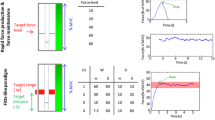Abstract
Six young (aged 18–22 years) and six older (aged 66–76 years) healthy humans participated in a visually guided isometric force modulation training program designed to improve accurate control of force during ankle dorsiflexion. Isometric force and the discharge activity of motor units (MU) supplying the tibialis anterior muscle were sampled concurrently at the beginning of the study, following 2 weeks of force modulation training and again after a 4 week retention period which followed immediately. The initial maximal voluntary force (MVC) and MU discharge rates were similar between young and older adults at 10–60% MVC while MU discharge rates during maximal effort were significantly reduced in older adults. Following the 2 weeks of force modulation training, both young and older adults demonstrated significant improvements in force accuracy (44% young, 48% older) and significantly reduced MU discharge rates at 30%, 40%, and 60% MVC. Young adults also demonstrated increased MVC force (11%), while older adults demonstrated significantly increased (30%) maximal MU discharge rate. Thus, following 2 weeks of force modulation training, young and older individuals demonstrated similar MU discharge rates at all force levels. The MU discharge rate adaptations were retained after the 4 week retention period. In young adults, improved force accuracy and increased MVC force were accompanied by significantly reduced MU recruitment thresholds. In the older subjects, improved force accuracy was accompanied by an increase in the difference between the recruitment-derecruitment force threshold and significantly reduced antagonist co-contraction. Age-related alterations in force regulation and MU discharge activity cannot be explained solely on the basis of contractile changes in senescent muscle. Rather, reliance on compensatory neuromuscular changes including antagonist muscle co-contraction is suggested.
Similar content being viewed by others
Author information
Authors and Affiliations
Additional information
Accepted: 27 June 2000
Rights and permissions
About this article
Cite this article
Patten, C., Kamen, G. Adaptations in motor unit discharge activity with force control training in young and older human adults. Eur J Appl Physiol 83, 128–143 (2000). https://doi.org/10.1007/s004210000271
Issue Date:
DOI: https://doi.org/10.1007/s004210000271




